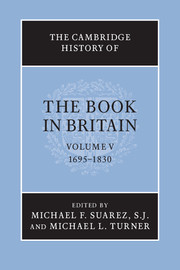Book contents
- Frontmatter
- Introduction
- PART I THE QUANTITY AND NATURE OF PRINTED MATTER
- PART II ECONOMIC, LEGAL AND CULTURAL CONTEXTS
- PART III THE TECHNOLOGIES AND AESTHETICS OF BOOK PRODUCTION
- PART IV THE BOOK TRADE AND ITS MARKETS
- V BOOKS AND THEIR READERS
- I RELIGIOUS BOOKS
- 30 Religious publishing
- 31 The Bible trade
- 32 The publishing and distribution of religious books by voluntary associations: from the Society for Promoting Christian Knowledge to the British and Foreign Bible Society
- II LITERATURE AND THE CULTURE OF LETTERS
- III SPECIALIST BOOKS AND MARKETS
- Abbreviations used in bibliography
- Bibliography
- Index
- Frontispiece
- Plate section
30 - Religious publishing
from I - RELIGIOUS BOOKS
Published online by Cambridge University Press: 28 September 2010
- Frontmatter
- Introduction
- PART I THE QUANTITY AND NATURE OF PRINTED MATTER
- PART II ECONOMIC, LEGAL AND CULTURAL CONTEXTS
- PART III THE TECHNOLOGIES AND AESTHETICS OF BOOK PRODUCTION
- PART IV THE BOOK TRADE AND ITS MARKETS
- V BOOKS AND THEIR READERS
- I RELIGIOUS BOOKS
- 30 Religious publishing
- 31 The Bible trade
- 32 The publishing and distribution of religious books by voluntary associations: from the Society for Promoting Christian Knowledge to the British and Foreign Bible Society
- II LITERATURE AND THE CULTURE OF LETTERS
- III SPECIALIST BOOKS AND MARKETS
- Abbreviations used in bibliography
- Bibliography
- Index
- Frontispiece
- Plate section
Summary
Introduction: denominations and publishers
Religious books and pamphlets of all kinds indisputably constituted the largest part of the publishing market in the period 1695 to 1830, just as they had since the invention of printing. They fell into three main categories, doctrinal, controversial and practical (the last meaning didactic and devotional in the widest sense), though with inevitable overlap between them. This chapter will concentrate on aspects of the third and largest category, which contained a huge range of books of different size, length and price aimed at different audiences. It included aids to religious worship, such as hymns and guides to communion; didactic aids, ranging from manuals for divinity students to catechisms for children; and devotional aids, teaching the reader how to live a devout Christian life both private and public. The writers of such books were mostly clergy or ministers of different denominations, though there were some lay authors; their readers, depending on the kind of book and how it was distributed, were the clergy and large numbers of the laity. Religious books were written and produced for clearly defined markets: the most expensive folio or quarto volumes – usually collected works or commentaries – for scholarly or ministerial or gentry libraries, medium-pricedoctavo handbooks or duodecimo pocket-books for clergy and prosperous laity, and cheap duodecimo or smaller pamphlets or tracts for the middling sort or for the prosperous to distribute to the poor. Denominational factors as well as economic and social ones determined the size and kind of publications: thus specific books were published for the differing liturgical and doctrinal needs of different denominations, though it is clear that some of the most popular works crossed denominational boundaries.
- Type
- Chapter
- Information
- The Cambridge History of the Book in Britain , pp. 577 - 600Publisher: Cambridge University PressPrint publication year: 2009
- 2
- Cited by



